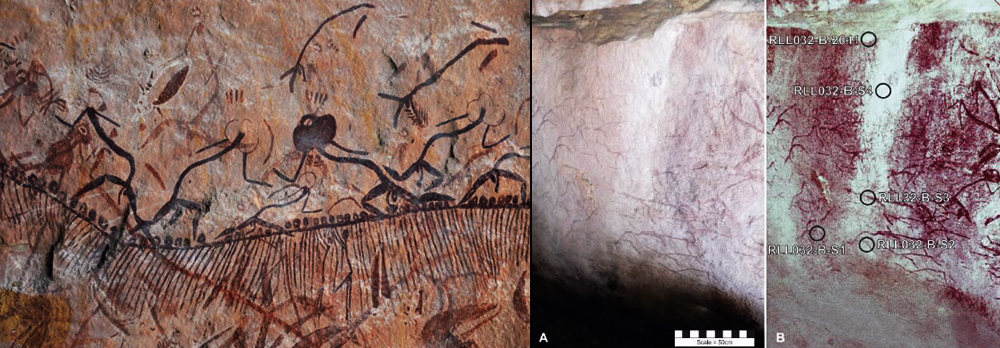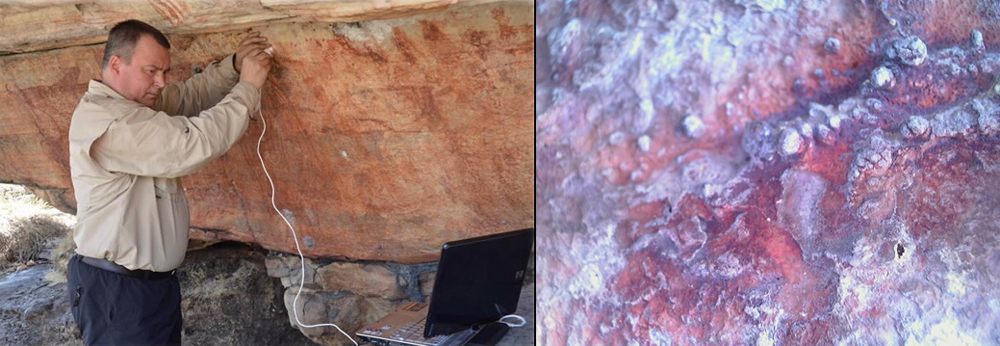


An article posted by the Australian Nuclear Science & Technology Organisation (ANSTO) - Development of new techniques makes it possible to date Australian Aboriginal rock art - reports on a new technique developed at ANSTO's Centre for Accelerator Science which has made it possible to produce some of the first reliable radiocarbon dates for Australian rock art.

Aboriginal rock art (left) from western Arnhem Land depicts style known as Northern Running Figures. Image: Tristen Jones. White mineral coating (right) descending down the rock face. Samples for radiocarbon highlighted. Image: Tristen Jones. Image enhancement: Daryl Wesley.
In a study just published online in The Journal of Archaeological Science Reports, the approach involved extracting calcium oxalate from a mineral crust growing on the surface of rock art from sites in western Arnhem Land, according to paper co-author research scientist Dr Vladimir Levchenko, an authority on radiocarbon dating using accelerator mass spectrometry.
Levchenko, who supervised the radiocarbon dating, collaborated with lead author of the paper, Ms Tristen Jones, a PhD candidate at the Australian National University (ANU) and co-authors from ANU.
A benchmark for dating rock art in #Australia https://t.co/oxS71yHG8r #RockArt #archaeology pic.twitter.com/NJWwyi4CJr
— Bradshaw Foundation (@BradshawFND) December 15, 2016
Lead author Tristen Jones and Njanjma Ranger Hilton Garnarrdj undertaking portable Fourier transform infrared spectroscopy on rock art.
Radiocarbon dating cannot readily be used to date Australian indigenous rock art directly, because it is characterised by the use of ochre, an inorganic mineral pigment that contains no carbon. However, the paper authors explain that carbon found in the mineral crusts on the rock surface was most probably was formed by microorganisms.
Levchenko states that these microorganisms are photosynthetic bacteria, like cyanobacteria or algae, which can utilise carbon from the air normally, and are active through wet periods.
A benchmark for chromometric data for rock art in Australia and elsewhere? The approach has produced an upper and lower limit of dates for a regional art style known as Northern Running Figures (NRF) or Mountford figures, believed to have been produced in Australia during the early to mid-Holocene (10,000 - 6,000 years ago). The archaeologists suggested the maximum age is likely to be far older.
The limited distribution of the NRF style and it's unclear relationship to earlier and later art styles has posed challenges for rock art researchers. Jones et al report that the minimum age of the NRF rock art style (based on the oldest sample) is reported to be 9034 - 9402 BP (before present), which also produces a minimum age for other art styles that occur in the 'Middle Period' sequence.

Dr Vladimir Levchenko (left) taking micro photographs of the oxalate crust at one of the the sites. Microphoto captures crystal growth (right) over the ochre pigment (sample RLL3-1-2).
Jones states that the results are exciting as although they generally support the chronology and assumed antiquity for the NRF art style, they provide minimum ages which suggest that the art style is actually a few thousand years older than what was anticipated. They also demonstrate that the art style was painted over a considerably long period. Most excitingly the results also provide the chronometric data to support a Pleistocene antiquity for the earliest known figurative art styles, such as Dynamic Figures, in Arnhem Land.
Levchenko explains that the figure depicted in the painting cannot be younger than the growth upon it; determining the radiocarbon ages using only the calcium oxalate minerals greatly improves the accuracy.
The research had the full support of the local Manilakarr Clan estate in western Arnhem Land and is the result of a long term collaboration with Ms Jones and other ANU collaborators with the Njanjma Rangers and the Djabulukgu Association. Senior Traditional Owner for the Manilakarr Clan estate Mr. Alfred Nayingull was a co-author on the paper.
The Journal of Archaeological Science Reports:
Radiocarbon age constraints for a Pleistocene Holocene transition rock art style: The Northern Running Figures of the East Alligator River region, western Arnhem Land, Australia
Tristen Jones et al
Abstract
In this article we present nine radiocarbon age determinations producing a minimum age and a minimum age range for a regionally distinct rock art style known as the Northern Running Figures from Red Lily Lagoon, western Arnhem Land Australia. These radiocarbon determinations provide age constraints for both Pleistocene and early Holocene rock art in western Arnhem Land. The radiocarbon age determinations are produced from extracting calcium oxalate contained within mineral crusts associated with the rock art. Significantly this study employs a novel separation technique, designed to effectively isolate the oxalate compounds from the mineral crust sample using chemical pre-treatment, and demonstrates significant time offsets between radiocarbon age determinations for the calcium oxalates and other carbon inclusions contained within mineral crusts.
Visit the Australian Rock Art Archive:
http://www.bradshawfoundation.com/bradshaws/index.php
by Bradshaw Foundation
Monday 30 May 2022
by Bradshaw Foundation
Wednesday 19 January 2022
by Bradshaw Foundation
Thursday 06 January 2022
by Bradshaw Foundation
Monday 06 December 2021
by Bradshaw Foundation
Monday 29 November 2021
by Bradshaw Foundation
Monday 25 October 2021
by Bradshaw Foundation
Monday 12 July 2021
by Bradshaw Foundation
Monday 24 May 2021
by Bradshaw Foundation
Tuesday 20 April 2021
by Bradshaw Foundation
Thursday 01 April 2021
by Bradshaw Foundation
Tuesday 23 February 2021
by Bradshaw Foundation
Thursday 14 January 2021
by Bradshaw Foundation
Friday 18 December 2020
by Bradshaw Foundation
Sunday 06 December 2020
by Bradshaw Foundation
Thursday 26 November 2020
by Bradshaw Foundation
Wednesday 07 October 2020
by Bradshaw Foundation
Monday 30 May 2022
by Bradshaw Foundation
Wednesday 19 January 2022
by Bradshaw Foundation
Thursday 06 January 2022
by Bradshaw Foundation
Monday 06 December 2021
by Bradshaw Foundation
Monday 29 November 2021
by Bradshaw Foundation
Monday 25 October 2021
by Bradshaw Foundation
Monday 12 July 2021
by Bradshaw Foundation
Monday 24 May 2021
by Bradshaw Foundation
Tuesday 20 April 2021
by Bradshaw Foundation
Thursday 01 April 2021
by Bradshaw Foundation
Tuesday 23 February 2021
by Bradshaw Foundation
Thursday 14 January 2021
by Bradshaw Foundation
Friday 18 December 2020
by Bradshaw Foundation
Sunday 06 December 2020
by Bradshaw Foundation
Thursday 26 November 2020
by Bradshaw Foundation
Wednesday 07 October 2020
Friend of the Foundation











